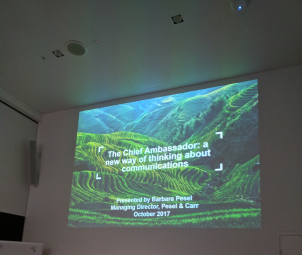20 reasons why podcasting is the next big thing

To commemorate Pesel & Carr’s 20th year, we are publishing a series of our top 20 tips, recommendations, insights and more, right here on our website.
Testing, testing… In today’s edition, we look at the top 20 reasons why podcasting is the next channel you should look into.
Podcasting is portable and convenient. In the age of smartphones and tablets, reading entire articles can be a taxing job and standing out in the online crowd an even harder one. But with podcasting, it’s all done ‘on the go’. Whew!
Podcasting is Australia’s fastest growing content medium.
While there are no available statistics on exactly how many people listen to podcasts in Australia, research conducted by Edison in the United States estimated 17% of Americans have listened to at least one podcast during the previous month.
It’s one of the most popular forms of entertainment and information next to television; the average podcast audience listens to an average of 5.5 podcasts per week.
It provides an excellent way to reach out and build a community, and provides a new and unique touchpoint through which to engage your target audience.
You only need to spend a little money in order to make money. Yep, you heard that correctly, launching a quality podcast doesn’t have to involve breaking the bank, especially when the start-up equipment can be as simple as a laptop and a mic; and
Being a tech wizard isn’t a prerequisite. The beauty of podcasting is that it offers a simple, intimate and accessible way for even the most niche brand to tell its story in a chatty and conversational way.
Podcasts can help an organisation or individual in becoming a thought leader within their industry, providing another platform to share their expert insights.
The creative freedom afforded by podcasts ensures that audiences hear from a wide variety of speakers, guests and industry professionals – all from rich backgrounds.
10. Spontaneity is what brought the subscriber back. Even if rehearsed a dozen times, going off-script and making ‘errors’ can be inevitable. But the good news is that this adds a natural and authentic quality to your brand.
11. It’s all about personality! Remember, you’re not reading slabs of written text. Show your audience how enthusiastic you are about the topic – tone is invaluable to fostering a connection with your audience.
12. Humanising your brand. Just like putting a face to the name, it doesn’t hurt to put a voice to the brand, either.
13. It’s also about practicality. Podcasting allows you to communicate more clearly what your key messages are within the episode. The enthusiasm and clarity in your message is only emphasised through your tone of voice.
14. You can say more for less. In a world full of character-restricted tweets and short, sharp blog posts, we’re forced to get our messages out as succinctly as possible. But with podcasts, the unrestricted time slots allows for deeper and more meaningful conversations.
15. Dare we say that maintenance isn’t required? One of the advantages of doing a podcast is that once the file has been launched, the podcast isn’t very hard to maintain.
16. Daily uploads are not required, or even expected, as free reign over the uploading schedule tends to be more common among podcasts than other channels.
17. As with any communication medium, putting out consistent material will help to build a decent-sized following. The same can be said for podcasting which, if done regularly, allows for brand loyalty to build among your subscribers.
18. Podcasts are audibly binge-worthy. Due to the free-flowing nature of podcasts the audience is far more likely to stick around and listen to the entire episode. And if they like it, chances of them coming in for another fix is likely.
19. They’re fun! Podcasts are a great way to showcase the individual flare of your brand as no two episodes should ever be the same.
20. They can also truly help achieve social change;
Last month Victoria Police release a podcast called Unspeakable, discussing real life cases of sexual crimes and ‘bringing their stories out from the shadows and into the light’.
In its short lifetime is has already seen huge success, reaching the number one spot on the iTunes chart. However it’s true success lies in its ability to truly make a difference in the community; in the first week the podcast was released, a victim of sexual crime came forward, and Victoria Police are now investigating.
If you’ve enjoyed this article, and are interested in how podcasting can work for you or your organisation, contact Pesel & Carr on 9036 6900.
What’s in a subject line?

This article was originally published in the October edition of 47, Pesel & Carr’s quarterly communications newsletter.
The Power of The Conversation

Let’s talk about the power of The Conversation … And no, we’re not talking about that vastly-diminishing art of picking up the phone for a chat or debating face-to-face.We’re talking about the website that’s become a powerful “go-to” source of ideas and information for journalists and the public.With the tagline ‘academic rigour, journalistic flair’, The Conversation describes itself as ‘an independent source of news and views, sourced from the academic and research community and delivered direct to the public’. It allows media to republish its articles free of charge under a “creative commons” licence.Pesel & Carr identified the publication as an ideal platform for helping a recent client, raise awareness of the need for better safety for healthcare workers.The article led directly to three TV interviews, two radio interviews, print publication in The Age and online publication on the ABC, News.com.au, Medical Observer and international news websites!Add to that a whole heap of social media engagement, including 2,100 shares of the original article on Facebook, 170 on Twitter and 75 on LinkedIn – a substantial social media conversation by any test.It’s something the website’s own published statistics could have easily predicted. The Conversation has a highly engaged community. After reading an article, on average, 85% of users discuss it with friends, 65% share it on social media, and 21% comment on the article. And after writing an article, 55% of authors are contacted by media publications.So, how did one of a new breed of online news sites become a much-relied upon resource for traditional media?In the six years since it was founded, The Conversation has developed a reputation as a trusted source of information, offering ‘explanatory journalism’ with pieces written by specialists in their respective fields. Indeed, all authors must be members of academic or research institutions such as a university or teaching hospital before they are permitted to publish.It’s a model that has immediate access to a global network of 33,000 academic experts for timely analysis and commentary. In a world where newsrooms are rapidly shrinking and media resources are becoming more and more stretched, it is no wonder that journalists are flocking to The Conversation.An added attraction is the purity and arguable lack of bias found in its content. The Conversation isn’t beholden to a traditional media funding model or political agenda. It takes no advertising and is a not-for-profit venture, paid for entirely through the higher education sector and reader donations.When interviewed in 2015 by The Independent , the founder of The Conversation and former editor of The Age Andrew Jaspan explained the origin of the publication: “I had to sack 30 people at The Age. We were losing specialists in areas like science and health … I had a discussion with the vice-chancellor of Melbourne University and I realised that the next stage for journalism could be a global newsroom in which everyone is a specialist.”So what’s in for the unpaid, expert contributors? Some want to contribute back to society through engaging the public in their ideas. Some use it as a platform to go on to write and provide commentary for other outlets, while other contributors are invited to speak at conferences and engage in research collaboration and business consultation.If your organisation has any connection with the academic or research world – through board members, industry collaborations or other relationships – it’s well worth exploring whether a piece in The Conversation by them could work for your client or you.
Communications: Why school principals need to be Chief Ambassadors

Last Friday, our MD Barbara Pesel shared her insights on The Chief Ambassador: A New Way of Thinking about Communications, at the Australian Council for Educational Leaders conference in Sydney.
Here are her key takeaways…
Principals are lead marketers for schools
It’s time for school leaders to shift their thinking about communications to secure the future of their schools – namely, enrolments. Like any business or organisation, schools needs to market when faced with a competitive environment and the lead marketer or ‘Chief Ambassador’ role falls squarely on the principal.
Every principal has a responsibility to build the school’s brand and proactively communicate the culture and vision of the school, both internally and externally. Developing a strong brand is a proactive way to safeguard reputation and enrolments.
To be successful you need clearly articulate what sets you and your school apart, and develop a marketing and communications plan that embraces the contemporary media and social media landscape.
Start with the end in mind
When we work with schools, the first thing we do is help them to articulate what we call their DNA.
A school’s DNA answers the important questions:
Why do you exist?
Where do you want to be as an organisation?
What do you stand for?
What makes you unique?
Once there is clarity the DNA is then reflected in the language, tone, visuals, messages and actions of principals, staff and school community – everyone needs to embrace it!
Messaging helps play an important role in developing and promoting brand
Think about how many people actually already know you and talk about you. Do they all say the same thing? Do they all know what you do? What you stand for? Importantly, what do you want them to know about you? Getting consistent messaging across to all of your stakeholders is not a small feat – let alone getting them to buy into your story. If you’re to have any hope, you need clarity, simple language and consistent messages across your communication channels.
As does planning
It all doesn’t magically happen – that would be nice! The amount of marketing and “Ambassadoring” you will be able to do will be determined by the resources available. However, it’s important to set out your activity in a plan with a timeline and map out some content for example, events, key dates, and the like. The trick is to stick to it and make sure the content supports your DNA. If your internal team don’t have the time or skills required, external consultants such as Pesel & Carr can help.
So what are some simple activities you can undertake?
Local media stories – a gold mine for lifting the profile of your school – you have a treasure trove of stories at your fingertips – make it part of your staff catch ups to find out what’s on the horizon
Writing a piece or blog piece for an educational magazine or website
Developing an opinion “comment” piece or Letter to the Editor on a cause that matters to you and your school
LinkedIn profiles making sure that all your staff members have a consistent message – supply a template
Facebook posts that have a call to action
Newsletters – make sure they are mobile friendly!
As Chief Ambassadors, it is important that principals drive and take an interest in how the school is portrayed.
Every principal has a responsibility to be the Chief Ambassador, internally and externally.
For further information, contact Pesel & Carr on (03) 9036 6900 or email info@peselandcarr.com.au
20 best snaps of Louis

To commemorate Pesel & Carr’s 20th year, we are publishing a series of our top 20 tips, recommendations, insights and more, right here on our website.
In this edition, we thought we’d show our recently promoted Culture Manager,a bit of love. Never one to shy away from the camera, or the affection of his doting co-workers, how better to do it than with 20 of our favourite pictures of Louis.
Rebranding an Aussie icon

This article was originally published on the Leadership Matters website.

